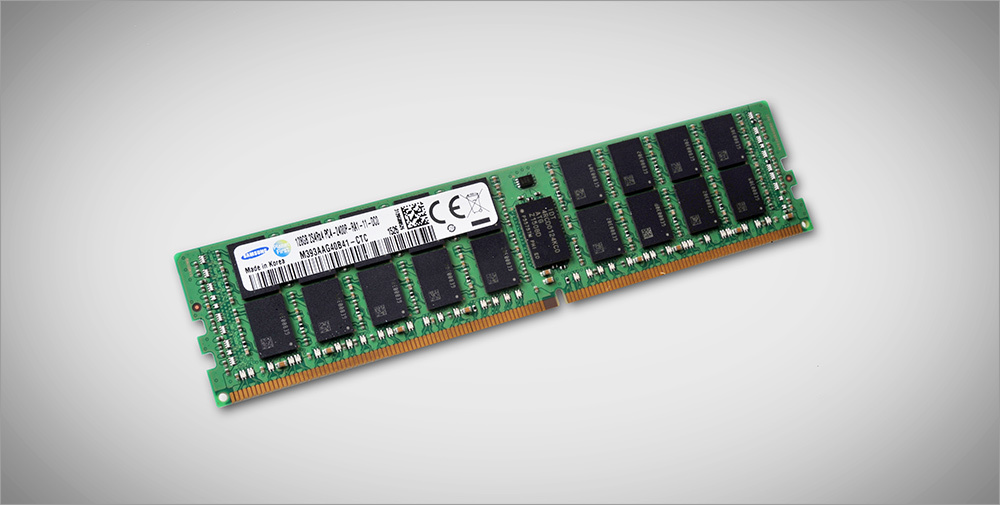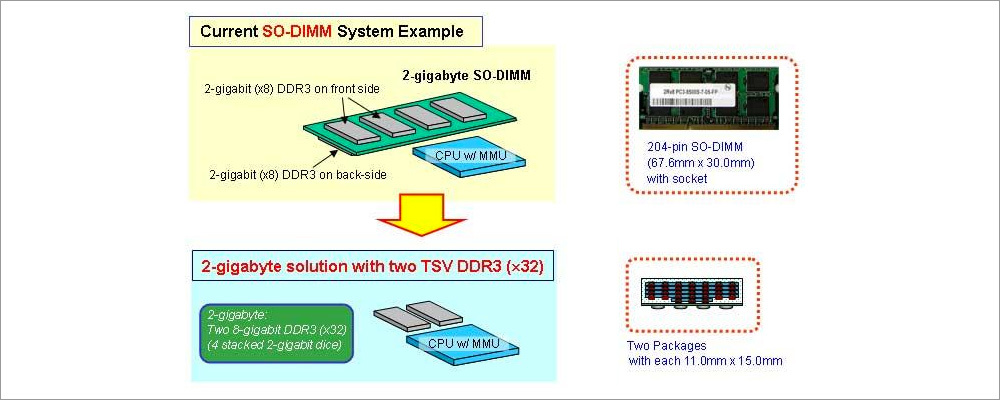Samsung launches TSV DDR4 128 Gb memory modules for servers
November 26 this year, Samsung Electronics announced the start of mass production of 128 GB of memory for corporate servers and data centers. TSV DDR4 128 Gb will be released based on TSV (“through silicon via”) technology.
Since 2014, Samsung Electronics has been releasing 64GB DDR4 RDIMMs based on 3D TSV technology. These modules are also designed for enterprise servers and cloud applications. RDIMMs include 36 DDR4 DRAM chips, each of which consists of four 4-gigabyte DDR4 DRAM crystals. Chips are manufactured using a 20 nm class process.
What is 3D TSV and what you need to know about it and how does it change our lives?

Compared to traditional-technology memory modules, the 64 GB 3D TSV DDR4 RDIMMs showed a double performance increase and a two-fold reduction in power consumption, Solid State Technology reports . Even then, the company announced the possibility of interconnecting more than four DDR4 crystals using 3D TSV technology, which will allow the creation of DRAM modules with an even higher density.
128-gigabyte DDR4 memory module using end-to-end vertical chip connection technology (TSV) and dual-row pin arrangement (RDIMM) consists of 144 DDR4 chips combined in 36 4 GB blocks, each of which has four 8-gigabyte chips of class 20 nm .
In addition, the main chip of each 4 GB packet acts as a data buffer, which allows optimizing performance and power consumption. The TSV chip packaging technology allows you to vertically connect DDR4 crystals with a thickness of several tens of microns, using electrodes through several hundred holes.
The industrial development of TSV technology (Through Silicon Via - vias in silicon), which allows us to switch from a planar arrangement of elements in (in one plane) to volumetric (elements are located one above the other), was announced in 2007 by IBM.

The essence of TSV technology is the formation of vias in silicon chips. These vias are filled with polysilicon or metal (copper, gold or tungsten), resulting in the formation of vertical conductors that bind the crystals in the stack.
The first IBM product to use TSV technology was a power amplifier for wireless telecommunication systems. According to the company, the use of TSV increased the energy efficiency of the amplifier by 40%.

Around the same time, NEC Electronics, Elpida Memory and Oki Electric began to develop chips using TSV technology. At the same time, TSV technology was then recognized as complex (vias occupied an additional area of the crystal, so it was necessary to make changes to its topology) and expensive.
The American company Vertical Circuits simultaneously with IBM patented another technology, thanks to which it was possible to increase productivity and reduce the energy consumption of chips - Vertical Interconnect Pillar (vertical interconnecting speakers). An additional metallization layer was formed on the finished semiconductor wafer with chip crystals, which brought pads to one of the edges of the chip. Then the whole plate was covered with polymer, in which windows were opened above the contact pads. Next, the plate was divided into crystals. Individual crystals were connected vertically, forming a stack. But the matter did not go beyond the patent.
Superiority in the massive use of TSV technology does not belong to Samsung. The industry's first TSV DRAM chip, combining eight DDR3 SDRAM chips in a single package, was developed by 2009 Japanese company Elpida Memory. In 2011, the company announced the start of the supply of DDR3 SDRAM chips, which also use TSV editing technology. The supplied samples were 8-Gbit DDR3 SDRAM chips that combine four 2-Gbit DDR3 SDRAM crystals and an interface unit in one package.

Source: 3dnews.ru
However, despite the promise of technology, 3D TSV until recently was widely used only for connecting to optical sensors in digital photo / video technology.
To date, the 128 GB TSV DDR4 RDIMM is the most energy-efficient server solution. According to Samsung, the data transfer rate is 2400 Mbit / s, which allows you to almost double the performance, reducing power consumption by 50% compared to 64 GB LRDIMM modules. A significant increase in performance is due to the fact that in LRDIMM stacks consist of four packets and are limited in power and data rate due to the traditional wired connection.
Samsung will unveil its new TSV DRAM product line over the next few weeks.
 Since 2008, we have leased dedicated and virtual servers for rent, we provide server hosting services in 4 data centers in Moscow, including two Tier III certified data centers. We specialize in large dedicated servers and creating private clouds and clusters for our clients based on them.
Since 2008, we have leased dedicated and virtual servers for rent, we provide server hosting services in 4 data centers in Moscow, including two Tier III certified data centers. We specialize in large dedicated servers and creating private clouds and clusters for our clients based on them.
For our readers, we have a hot offer: Servers available on the basis of T-Platform supercomputers and Intel Xeon E5-2630v2 processors with a 15% discount until the end of December (or until they end) using the TMW5U0S8SE promo code
For example, for comparison:
 - 2xE5 -2630v2 (12x2.6 GHz) / 64Gb RAM / 1x1Tb SSD + 1x1Tb 7.2K HDD = 17000r per month, with a discount of 14450.
- 2xE5 -2630v2 (12x2.6 GHz) / 64Gb RAM / 1x1Tb SSD + 1x1Tb 7.2K HDD = 17000r per month, with a discount of 14450.
- 2xE5-2630v2 (12x2.6 GHz) / 128Gb RAM / 1x2Tb SSD + 1x2Tb 7.2K HDD = 25700r per month, with a discount of 21800
- 2xE5-2630v2 (12x2.6 GHz) / 256Gb RAM / 2x2Tb Samsung SSD = 36500r per month, with a discount of 31000
- 2xE5-2630v2 (12x2.6 GHz) / 32Gb RAM / 2x600Gb SAS 10K = 13650r per month, with a discount of 11600r
All prices are inclusive of VAT, almost any configuration is possible.
All servers are connected on a gigabit channel, the traffic limit is 10 TB without bandwidth restrictions. Each dedicated server is provided with remote access via IPMI; VLAN can be organized at speeds up to 10Gbps.

Compared to traditional-technology memory modules, the 64 GB 3D TSV DDR4 RDIMMs showed a double performance increase and a two-fold reduction in power consumption, Solid State Technology reports . Even then, the company announced the possibility of interconnecting more than four DDR4 crystals using 3D TSV technology, which will allow the creation of DRAM modules with an even higher density.
128-gigabyte DDR4 memory module using end-to-end vertical chip connection technology (TSV) and dual-row pin arrangement (RDIMM) consists of 144 DDR4 chips combined in 36 4 GB blocks, each of which has four 8-gigabyte chips of class 20 nm .
In addition, the main chip of each 4 GB packet acts as a data buffer, which allows optimizing performance and power consumption. The TSV chip packaging technology allows you to vertically connect DDR4 crystals with a thickness of several tens of microns, using electrodes through several hundred holes.
What is TSV
The industrial development of TSV technology (Through Silicon Via - vias in silicon), which allows us to switch from a planar arrangement of elements in (in one plane) to volumetric (elements are located one above the other), was announced in 2007 by IBM.

The essence of TSV technology is the formation of vias in silicon chips. These vias are filled with polysilicon or metal (copper, gold or tungsten), resulting in the formation of vertical conductors that bind the crystals in the stack.
The first IBM product to use TSV technology was a power amplifier for wireless telecommunication systems. According to the company, the use of TSV increased the energy efficiency of the amplifier by 40%.

Around the same time, NEC Electronics, Elpida Memory and Oki Electric began to develop chips using TSV technology. At the same time, TSV technology was then recognized as complex (vias occupied an additional area of the crystal, so it was necessary to make changes to its topology) and expensive.
The American company Vertical Circuits simultaneously with IBM patented another technology, thanks to which it was possible to increase productivity and reduce the energy consumption of chips - Vertical Interconnect Pillar (vertical interconnecting speakers). An additional metallization layer was formed on the finished semiconductor wafer with chip crystals, which brought pads to one of the edges of the chip. Then the whole plate was covered with polymer, in which windows were opened above the contact pads. Next, the plate was divided into crystals. Individual crystals were connected vertically, forming a stack. But the matter did not go beyond the patent.
Superiority in the massive use of TSV technology does not belong to Samsung. The industry's first TSV DRAM chip, combining eight DDR3 SDRAM chips in a single package, was developed by 2009 Japanese company Elpida Memory. In 2011, the company announced the start of the supply of DDR3 SDRAM chips, which also use TSV editing technology. The supplied samples were 8-Gbit DDR3 SDRAM chips that combine four 2-Gbit DDR3 SDRAM crystals and an interface unit in one package.

Source: 3dnews.ru
However, despite the promise of technology, 3D TSV until recently was widely used only for connecting to optical sensors in digital photo / video technology.
To date, the 128 GB TSV DDR4 RDIMM is the most energy-efficient server solution. According to Samsung, the data transfer rate is 2400 Mbit / s, which allows you to almost double the performance, reducing power consumption by 50% compared to 64 GB LRDIMM modules. A significant increase in performance is due to the fact that in LRDIMM stacks consist of four packets and are limited in power and data rate due to the traditional wired connection.
Samsung will unveil its new TSV DRAM product line over the next few weeks.
A bit about HOSTKEY
 Since 2008, we have leased dedicated and virtual servers for rent, we provide server hosting services in 4 data centers in Moscow, including two Tier III certified data centers. We specialize in large dedicated servers and creating private clouds and clusters for our clients based on them.
Since 2008, we have leased dedicated and virtual servers for rent, we provide server hosting services in 4 data centers in Moscow, including two Tier III certified data centers. We specialize in large dedicated servers and creating private clouds and clusters for our clients based on them. For our readers, we have a hot offer: Servers available on the basis of T-Platform supercomputers and Intel Xeon E5-2630v2 processors with a 15% discount until the end of December (or until they end) using the TMW5U0S8SE promo code
For example, for comparison:
 - 2xE5 -2630v2 (12x2.6 GHz) / 64Gb RAM / 1x1Tb SSD + 1x1Tb 7.2K HDD = 17000r per month, with a discount of 14450.
- 2xE5 -2630v2 (12x2.6 GHz) / 64Gb RAM / 1x1Tb SSD + 1x1Tb 7.2K HDD = 17000r per month, with a discount of 14450. - 2xE5-2630v2 (12x2.6 GHz) / 128Gb RAM / 1x2Tb SSD + 1x2Tb 7.2K HDD = 25700r per month, with a discount of 21800
- 2xE5-2630v2 (12x2.6 GHz) / 256Gb RAM / 2x2Tb Samsung SSD = 36500r per month, with a discount of 31000
- 2xE5-2630v2 (12x2.6 GHz) / 32Gb RAM / 2x600Gb SAS 10K = 13650r per month, with a discount of 11600r
All prices are inclusive of VAT, almost any configuration is possible.
All servers are connected on a gigabit channel, the traffic limit is 10 TB without bandwidth restrictions. Each dedicated server is provided with remote access via IPMI; VLAN can be organized at speeds up to 10Gbps.
